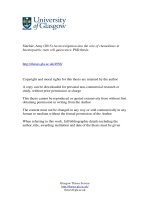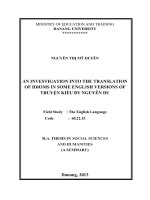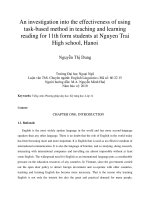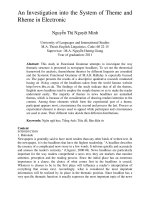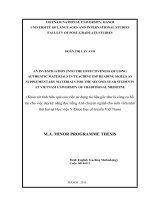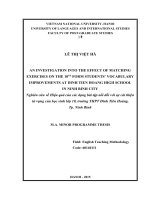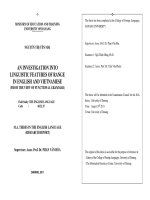An investigation into cognitive metaphors of homeland in trinh cong son’s versus bob dylan’s songs”
Bạn đang xem bản rút gọn của tài liệu. Xem và tải ngay bản đầy đủ của tài liệu tại đây (441.03 KB, 26 trang )
MINISTRY OF EDUCATION AND TRAINING
THE UNIVERSITY OF DANANG
NGUYỄN THỊ VIỆT
AN INVESTIGATION INTO COGNITIVE
METAPHORS OF “HOMELAND” IN
TRINH CONG SON’S VERSUS
BOB DYLAND’S SONGS
Field: THE ENGLISH LANGUAGE
Code:
60.22.02.01
M.A THESIS IN SOCIAL SCIENCES AND HUMANITIES
(A SUMMARY)
Danang - 2015
The thesis has been completed at the College of Foreign Languages,
The University of Danang.
Supervisor : Đinh Thị Minh Hiền, Ed.D
Examiner 1: Phạm Thị Hồng Nhung, Ed.D
Examiner 2: Hồ Vũ Khuê Ngọc, Ed.D
The thesis will be orally defended at the Examining Board at the
University of Da Nang
Time : 14/12/2014
Venue: The University of Danang
The original of the thesis is accessible for purpose of reference at:
- The College of Foreign Languages Library, The University of
Danang
- The Information Resources Centre, The University of Danang
1
CHAPTER 1
INTRODUCTION
1.1. RATIONALE
In recent decades, Cognitive metaphor (CM) has become a
new trend influencing on linguistics. In light of cognitive
linguistics, CM refers to the understanding of one idea, or conceptual
domain, in terms of another. Current study in this field emphasizes
the importance of metaphor in language, and it is considered an
essential and indispensable phenomenon in both language and
thought.
Lakoff and Johnson (1980, p.3) stated in “Metaphors We Live
By” that:
Metaphor is for most people a device of the poetic
imagination and the rhetorical flourish - a matter of extraordinary
rather than ordinary language. For this reason, most people think
they can get along perfectly well without metaphor. We have found,
on the contrary, that metaphor is pervasive in everyday life, not just
in language but in thought and action. Our ordinary conceptual
system, in terms of which we both think and act, is fundamentally
metaphorical in nature."
(Source: Lakoff and Johnson, Metaphor we live by, 1980, p3)
CM is used not only in literature and in our everyday lives but
also in music. It seems undeniable that music is one of the greatest
creations of human kind in the course of history. It is creativity in
pure and undiluted form of art. Music is a crucial element of
everyday life. It is not only a way of expressing our feelings and
emotions but also a way to escape life that gives us relief in pain,
helps us calm down or excites us with joy. In short, it touches our
feelings and enriches our mind.
2
As mentioned above, music becomes one of the important and
powerful things in one's life. Life without melodies and harmonies
would be totally empty. Songwriters, with their styles of composing and
vivid imagination, convey all sorts of emotions that can be joy and
happiness or sadness and despair through rhythms and melodies. TCS
and BD are such composers. Their music brings people together in love
and in protesting wars. And their use of the rhetoric device of CM has
made the two composers win the listeners' heart. However, it seems that,
there is hardly a study into "Homeland" in their songs in terms of CMs.
For all these reasons, I decide to carry out the research “An investigation
into Cognitive Metaphors of “Homeland” in TCS’s songs versus Bob
Dylan’s ones. I hope this study could meet the needs of the people who
are eager to work in the fields of language teaching, translation studies
and Cross-communication. And that means I would make a small
contribution to the development of CMs.
1.2. AIMS AND OBJECTIVES:
1.2.1. Aims
This study aims:
(i) to investigate how the image of "Homeland" is expressed in
Trinh Cong Son's and Bob Dylan's songs in terms of Cognitive
metaphor;
(ii) to discover the similarities and differences of Cognitive
metaphors related to the image of "Homeland" in Vietnamese and
English songs via Trinh Cong Son’s and Bob Dylan’s songs.
1.2.2. Objectives
With the above-mentioned purposes, this study is intended:
- To identify the Cognitive metaphors of "Homeland"
conceptualized in songs written by Trinh Cong Son and Bob Dylan.
3
- To categorize the Cognitive metaphors of “Homeland” in Trinh
Cong Son’s and Bob Dylan’s songs in light of Cognitive linguistics.
- To analyze and discuss the Cognitive metaphors of “Homeland”
in terms of Cognitive semantics and forms of expressive mappings.
- To find out the similarities and differences of the image of
"Homeland" in Trinh Cong Son's versus Bob Dylan's songs in terms
of Cognitive metaphor.
1.3. RESEARCH QUESTIONS
In order to achieve the aims of the study, the researcher
attempts to seek the answers to the following questions.
1. How are the Cognitive metaphors related to the image of
"Homeland" conceptualized in Trinh Cong Son's and Bob Dylan's songs?
2. What are the similarities and differences of Cognitive
metaphors of "Homeland" in Trinh Cong Son's and Bob Dylan's
songs in terms of Cognitive semantics?
1.4. SCOPE OF THE STUDY
1.5. DEFINITIONS OF TERMS
1.5.1. Cognitive Linguistics
1.5.2. Cognitive Metaphor
1.5.3. TCS and his music
1.5.4. BD and his music
1.5.5. Semantic features of word denoting Homeland
1.6. SIGNIFICANCE OF THE STUDY
1.7. ORGANZATION OF THE STUDY
Chapter 1: Introduction
Chapter 2: Literature Review and Theoretical Background
Chapter 3: Research design and Methodology
Chapter 4: Findings and discussions
Chapter 5: Conclusions and Implications
4
CHAPTER 2
LITERATURE REVIEW AND THEORETICAL
BACKGROUND
2.1. LITERATURE REVIEW
2.2. THEOETICAL BACKGROUND
2.2.1. Cognitive linguistics
2.2.2. Cognitive semantics
2.2.3. Cognitive metaphor
a. Definitions of CM
b. Classifications of CMs
Structural Metaphors
Ontological Metaphors
Orientation Metaphors
c. Metaphorical mappings
* Mapping principles
* Mapping
* Image schemas
2.3. SUMMARY
CHAPTER 3
RESEARCH DESIGN AND METHODOLOGY
3.1. RESEARH DESIGN AND METHODOLOGY
3.2. RESEARCH PARTICIPANTS
3.3. SAMPLING
3.4. RESEARCH INSTRUMENTS
3.4.1. The questionnaires
3.4.2. The interviews
3.5. RESEARCH PROCEDURE
- Read relevant research, theses, documents, books in order to
5
choose the most suitable ones for basic theoretical background.
- Collect and categorize all songs written by TCS and BD
denoting the image of "Homeland" in respect of CM.
- Discuss the results.
- Analyze and compare CMs of "Homeland" in songs of the
two authors.
- Pointing out the similarities and differences in CMs
expressing the image of "Homeland" between TCS and BD's songs.
- Suggesting some implications for the study.
3.6 VALIDITY AND RELIABILITY
CHAPTER 4
FINDINGS AND DISCUSSION
4.1.RESULTS FROM THE QUESTIONNAIRE AND INTERVIEW
4.1.1. With Yes/ No Questions
4.1.2. With Multiple-choice questions
4.1.3. With Scale-rating questions
The results in the questionnaire reveal that the number of
responders who understood CM is more than those who did not (90%
out of responders in the questionnaires as compared with 100%
responders in the interviews). This helps the researcher confirm the
validity of the study as this figure gives valuable and meaningful
cues to the investigation. However, there are still 10% of responders
in the questionnaire stated they did not have any idea about CM. This
figure makes us wonder why these responders do not know CM and
highlights the importance of finding solutions for this significant
minority (Q1&I1, Table 1). In respect of question items from 10 to
32 (see appendix 1 & 2), the percentages for “Yes” answers are from
65% to 98%. These percentages are high enough for the researcher to
6
set up a basic foundation to analyze, compare and discuss the CMs of
“Homeland” in TCS’s and BD’s songs.
In question item 10 “Do you realize the CM implied in songs
when listening to music?” 80% of the responders realize the CMs
implied in songs. It is interesting that 95% out of responders enjoyed
songs related to “Homeland”. Most of the responders (67% and 100,
respectively %) stated that the images in the songs made them think
of “Homeland”. The responses in the questionnaire and interviews
with responders show that the percentage of responders who agree to
the view of Homeland is a part of a whole and Homeland is natural
phenomena are very high when mentioning “Homeland”. Responses
to question items 18, 19, 20 and 21 reveal that most of the responders
(65%, 60%, 81% and 75%, respectively) agreed with the ideas of
CMs of “Homeland” in both TCS’s and BD’s songs such as
Homeland is up, Homeland is down.
As mentioned in the questionnaire, regarding question items 22
and 23, most of the candidates confirm that CMs Homeland is a
substance in a container exists in both TCS’s and BD’s songs.
Additionally, the majority of them (92%) say “Yes” with question
items 24 (Homeland is an entity) in the process of interview.
In the questionnaire, the percentages supporting the view of
Homeland is fire (in Q25& Q26) respectively occupied 90% and
89%. In the interview, 93% to 100% candidates agreed that the view
of “Homeland is fire” occurred in both TCS’s and BD’s songs
(Q25&I25; Q26&I26; Table 1).
The researcher also received a high agreement from the
responders for the CMs of Homeland is fluid in a container (77%
from the questionnaire and 74% from the interview), Homeland is
loss (95% & 91%), Homeland is a plant (91% & 89%).
7
From question 33 to question 36, most of the responders (from
86.5% to 100%) thought that comprehending CM would benefit them
in many fields like enjoying art works effectively (100%), improving
their translating and interpreting skills (94%), as well as bettering
their communicating skills (86.5%)
In Multiple choice Question section, responses to question item 3
reveal that more responders thought that CMs occurred mostly in
literature (35%) rather than in music (25%), poet (20%) and newspaper
(10%). And these percentages are not big different as compared with
those in the interview. Results in the questionnaire and interviews prove
that a considerable amount of responders have correct definition of CM
(Q4 & I4, table 3). Regarding question items 5 in both questionnaire
interviews, half of the candidates stated that they often listen to lyric
songs, among which 30% out of them chose songs for homeland and
13%, 7% for folk music and rock respectively.
In Scale-rating Question section, responses to question item 2
show that 85% out of the responders understood CMs, among which
12% out of them mastered it and 38% comprehended it at an average
level. In question item 6, it is not surprising that all responders
enjoyed TCS’s songs and stated that his music was so popular in
Vietnam. Hence, the question “Do you like listening to TCS’s song”
received 89% “Yes” answer from the questionnaire and 83% from
the interviews. However, not many of them used to listen to TCS’s
music. This might due to the fact that (i) TCS’s music is highly
philosophical that the young generation could not fully appreciated;
(ii) the young generation did not experience the hardship to loss and
pain caused by war in the old days. Therefore, they have much
interest in listening to modern music rather than listening to TCS’s
songs. Regarding BD’s music, although up to 92% out of responders
8
have enjoyed his songs, there are still 8% remainders reporting that
they have not heard of his music.
4.2. COGNITIVE METAPHORS DENOTING THE CONCEPT
OF HOMELAND IN TCS’S VERSUS BD’S SONGS
4.2.1. Homeland is a plant
The CM Homeland is a plant appears repeatedly in TCS’s and
BD’s songs. In this CM, “Homeland” is conceptualized as a plant.
Basically, trees, leaves, flowers, etc. are also implied as plants. They
are normally seen in one’s daily life. Besides flowers, trees and
leaves, there are various kinds related to plants such as field, hill,
garden, branch, sow, seed, bud used to bring new meanings and new
ideas of homeland.
Chiều trên quê hương tôi
Có khi đây một trời mưa bay
Có nơi kia đồi thông nắng đầy
Có trên sông bờ xa sương khói
Chiều Trên Quê Hương Tôi – Trinh Cong Son
I'll be home for Christmas
You can count on me
Please have snow and mistletoe
And presents on the tree
I'll Be Home For Christmas – Bob Dylan
Việt Nam ơi xác thêm hơi cho đất ngày mai
...
Bên xác người già yếu, có xác còn thơ ngây
Xác nào là em tôi, dưới hố hầm này
Trong những vùng lửa cháy, bên những vồng ngô khoai
Bài Ca Dành Cho Những Xác Người – Trinh Cong Son
Oh the benches were stained with tears and perspiration
9
The birdies were flying from tree to tree
There was little to say, there was no conversation
As I stepped to the stage to pick up my degree
Day Of The Locusts – Bob Dylan
Table 4.4: CMs Expressing Homeland is a Plant
Target domain
Source domain
Quê, quê hương (homeland,
Hoa (flower), cây (tree), cánh
home), phố (street), trăng (moon), đồng (field),khu rừng (forest),
ánh trăng (moonlight), nhà
nhánh cây (branch)
(home), làng (village), công viên
(park)
4.2.2. Homeland is up
The next CM characterizing the conceptualization of Homeland
in TCS’s and BD’s songs is an orientational metaphor: Homeland is up.
The images appearing in their songs indicate an “upward” orientation.
This can be seen through the following examples:
Em còn nhớ hay em đã quên ?
Trong lòng phố mưa đêm trói chân
Dưới hiên nhà nước dâng tràn
Phố bỗng là giòng sông uốn quanh
Em Còn Nhớ Hay Em Đã Quên – Trinh Cong Son
Old pulses running through my palm,
the sharp hills are rising from
Yellow fields with twisted oaks that grow
Moonlight – Bob Dylan
Ngàу Việt Nam mênh mang trầm hương đốt ấm
...
Vì quanh đây nhờ anh người người đã sống trong yên lành
vượt lầm than tên anh là cây đuốc sáng
một vạn cánh chim bay lên trong trời, hót mãi tình anh
10
Ngày Mai Đây BìnhYên – Trinh Cong Son
Well, I've walked two hundred miles, look me over
It's the end of the chase and the moon is high
When The Night Comes Falling From The Sky – Bob Dylan
Table 4.5: CMs Expressing Homeland is Up
Target domain
Source domain
Phố (street), hiên nhà (veranda),
Chim bay lên (birds fly up),
cánh đồng (field), thuyền (boat),
nước dâng tràn (water rises),
khói (smoke), sông (river), trầm cây mọc (oaks grow), sao trên
hương, Việt Nam,
cao (stars above)
4.2.3. Homeland is down
The CM Homeland is down is the opposite of the above CM
Homeland is up. The images used in their songs, needless to say,
indicate a “downward” orientation. This mapping occurs so
frequently in both TCS’s and BD’s songs.
Ta nghe tình đổi mùa
Rừng đông rơi chiếc lá
Ta cười với âm u
Trên quê hương còn lại
Những Con Mắt Trần Gian – Trinh Cong Son
Outside of two men on a train platform there's nobody in sight
They're waiting for spring to come, smoking down the track
I and I – Bob Dylan
Thành phố vẫn nắng vàng, vẫn mưa
Cây sang Thu lá úa rơi mù
Chuyện ngày xưa heo hút trong mơ
Tạ Ơn – Trinh Cong Son
Look out across the fields, see me returning
......................................
You'll love me or I'll love you
11
When the night comes falling
When The Night Comes Falling From The Sky – Bob Dylan
Table 4.6: CMs Expressing Homeland is Down
Target domain
Source domain
Quê, quê hương (homeland, home),
Lá rơi , trút, đổ, rớt, rụng
phố (city), trăng (moon), ánh trăng
(leaves fall), xuống (down),
(moonlight), mặt trời (sun), cánh
mặt trời lặn (sun sets), đêm
đồng (filed), sông (river)
xuống (night falling)
4.2.4. Homeland is fire
Historically, fire is the typical symbol for war. Burning houses,
burning fields, burning forests are popular images that are
representative for homeland in the war time. These images make
people feel frightened, stressful and anxious. Fire causes even death
to people and everything around. By means of fire, both authors want
to accuse invaders causing war.
Hàng vạn tấn bom trút xuống đầu làng
Hàng vạn tấn bom trút xuống ruộng đồng
Cửa nhà Việt Nam cháy đỏ cuối thôn.
Đại Bác Ru Đêm – Trinh Cong Son
In the city's melted furnace, unexpectedly we watched
.........................................................
Even though a cloud's white curtain in a far-off corner flashed
An' the hypnotic splattered mist was slowly lifting
Electric light still struck like arrows, fired but for the ones
Chimes Of Freedom – Bob Dylan
Khi đất nước tôi thanh bình, tôi sẽ đi thăm,
tôi sẽ đi thăm, làng xóm thành đồng
đi thăm từng khu rừng cháy nám
Tôi Sẽ Đi Thăm – Trinh Cong Son
Maybe someday you'll have no where to turn
12
You'll look back and wonder about
the bridges you have burned
Maybe Someday – Bob Dylan
Table 4.7: CMs Expressing Homeland is a Fire
Target domain
Source domain
Làng (village), ruộng đồng (field), đường phố Nhà cháy (house
(highway), đất nước (country), phố (city),
fire, burn), lửa
công viên (park), đường phố (street), quê
(fire)
hương (homeland), cầu (bridge), nhà (house),
mặt trời (sun), đồn điền (plantation)
4.2.5. Homeland is loss
“Homeland is loss” is a common phenomenon in TCS’s and
BD’s anti-war songs. War causes great loss for nature, environment,
and especially for people. War causes pain, even death to not only
soldiers in the battle but also to women, elderly people and small
children as well.
Xác người nằm trôi sông, phơi trên ruộng đồng
Trên nóc nhà thành phố, trên những đường quanh co.
Xác người nằm bơ vơ, dưới mái hiên chùa
Trong giáo đường thành phố, trên thềm nhà hoang vu
Bài Ca Dành Cho Những Xác Người – Trinh Cong Son
Did you ever hear them church bells toll
Means another poor boy is dead and gone.
See That My Grave Kept Clean – Bob Dylan
Tôi có người yêu ở chiến khu "Đ"
Chết trận Đồng Xoài, chết ngoài Hà Nội
Chết vội vàng dọc theo biên giới.
Tình Ca Của Người Mất Trí – Trinh Cong Son
The country I come from
Is called the Midwest
13
....
The Indians fell
The cavalries charged
The Indians died
With God On Our Side – Bob Dylan
4.2.6. Homeland is a part of a whole
It can be seen that in TCS’s and BD’s songs, eyes, heart, face,
hair, hand, foot, waist, voice are considered parts of a human body.
They are brought in the two authors’ songs metaphorically to show
people’s pain and loss as the consequences of war.
Ruộng đồi quê hương dấu vết bom qua
Từng bàn tay thô, lấp kín môi cười
Từng cuộn dây gai, xé nát da người
Đạn về đêm đêm, đốt cháy tương lai
Người Già Em Bé – Trinh Cong Son
As that old train pulled out, John’s ma began to shout
.......................................
And through the roar and smoke, that string, it finally broke,
And a blast of fire blew my eyes away
John Brown – Bob Dylan
Gặp quê hương sau bão tố
....
Bàn tay muôn vạn bàn tay
Những ngón tay thơm nối tật nguyền
Nối cuộc tình nối lòng đổ nát
Bàn tay đi nối anh em
Ta Thấy Gì Đêm Nay – Trinh Cong Son
She's waiting at home like a patient saint
Her fond face pale with woe
Her heart will be broken when I am gone
14
.....
Straight was the track to the top of the hill,
Two Soldiers – Bob Dylan
Table 4.9: CMs Expressing Homeland is a Part of a Whole
Target domain
Source domain
Quê hương (homeland), tàu
Da (skin), xương (bone), con tim
(train), ngọn đồi (hill), tòa
(heart), mặt (face), bàn tay (hand),
nhà (building), đường
ngón tay (finger), thắt lưng (waist),
(highway), võng (hammock),
giọng nói (voice), môi (lip), mắt
nước nhà (country)
(eye), miệng (mouth), tóc (hair)
4.2.7. Homeland is fluid in a container
The images of rivers, teardrops, blood also remind us of
homeland. In the CM Homeland is fluid in a container, the fluid here
can be listed as tears, blood, water and teardrops. They appear with
high frequency in their songs to imply the loss people have to bear,
their hatred and the love to their native land in the war time. River,
frost, rain and cloud are also forms of fluid by nature that exist in a
container. Let us take a look at the following instance:
Từng dòng suối con kênh đầu làng
Đã mang hình bóng quê hương
Đã nuôi giòng máu trong tim
Tình Yêu Tìm Thấy –Trinh Cong Son
I'll walk to the depths of the deepest black forest
Where the people are a many and their hands are all empty
Where the pellets of poison are flooding their waters
A Hard Rain's A-Gonna Fall – Bob Dylan
Còn nụ cười trên đôi môi
Còn trái tim chân ta còn tới
vì giống nòi vì nước nhà tả tơi
Xin anh chị hãy vùng lên
15
Đừng Mong Ai Đừng Nghi Ngại – Trinh Cong Son
We're two of a kind and our blood runs hot
But we're no way similar in body or thought
All husbands are good men is all I knew
Then she pierced him to the heart and his blood did flow
...
Through the towns and the villages all night and all day
Tin Angel – Bob Dylan
Table 4.10: CMs Expressing Homeland is Fluid in a container
Target domain
Source domain
Quê, quê hương (homeland),
Máu (bood), tim (heart),
rừng (forest), tàu (train), liễu
biển (beach), giọt lệ
(willow tree), suối (steam), làng
(teardrop), giọt sương
(village), bờ biển (seaside), biển
(dewdrop), khói (smoke),
(beach), phố (city),
mây (cloud)
4.2.8. Homeland is a substance in a container
It is commonly for the composers to choose common and
familiar images to write for their fatherland. TCS as well and BD are
such songwriters. River, field, train, village, market, dyke, bridge,
flower, street, train, kite, smoke, hammock are typical images named
in their songs. They are repeated a lot in their songs.The homeland
either appears in war time or in peace, when war was over.
Tìm lại đôi tay cho mẹ về thăm lúa
Họp chợ đêm nay chi gánh em gồng
Tìm lại con đê cho một bầy em bé
Tìm làng tre xanh cho làng mạc miền quê
Đôi Mắt Nào Mở Ra – Trinh Cong Son
Look out across the fields, see me returning
Smoke is in your eye, you draw a smile
16
From the fireplace where my letters to you are burning
You've had time to think about it for a while.
When The Night Comes Falling From The Sky – Bob Dylan
Nhớ đường dài qua cầu lại nối
Nhớ những con kênh nối hai giòng sông
Nhớ ngựa thồ ngoại ô xa vắng
Nỗi xôn xao hàng quán đêm đêm
Em Còn Nhớ Hay Em Đã Quên – Trinh Cong Son
See them big plantations burning
Hear the cracking of the whips
Smell that sweet magnolia blooming
Blind Willie Mctell – Bob Dylan
Table 4.11: CMs Expressing Homeland is a Substance in a
container
Target domain
Source domain
Quê
hương
Hoa (flower), cây (tree), cánh đồng
(homeland),
phố
(field), chợ (market), làng (village),
(city), nhà (house),
đường xá (highway), đồn điền
(plantation), dòng sông (river), biển
(sea), the stage, the altar
4.2.9. Homeland is natual phenomena
Phenomena such as storm, rain, sun storm, gales, wind,
hurricane and the like are closely associated with homeland. These
events occur annually and bring disadvantages to human beings and
damage natural environment. Hence, when someone misses
hometown, he/ she certainly thinks of devastation and loss people
have to suffer. The CM Homeland is natural phenomena can be
found through the following illustrations:
Người tìm về dòng sông
Hỏi thầm về đời mình
17
Hoang vu dòng nước lũ
Lời Của Dòng Sông – Trinh Cong Son
Well, if you go when the snowflakes storm
When the rivers freeze and summer ends
Please see for me if she's wearing a coat so warm
To keep her from the howlin' winds.
Girl From The North Country- Bob Dylan
Ta thấy em trong tiền kiếp với mặt trời lẻ loi
Ta thấy em đang ngồi hát khi rừng về nhiều mây
Rừng thu thay lá mưa bay buồn rầu
Rừng đông buốt giá mưa bay dạt dào
Rừng Xưa Đã Khép – Trinh Cong Son
Through this open world I'm about to trouble
Through ice and snows, sleet and rain
I'm about to ride that morning railroad
Perhaps I'll die on that train.
Man Of Constant Sorrow- Bob Dylan
Table 4.12: CMs Expressing Homeland is Natural phenomena
Target domain
Source domain
Thành phố (city), góc Biển động (rough sea), sấm (thunder),
phố (corner), giòng sông lũ (flood), sương mù (mist), nắng
(river), biển (sea), ruộng (sunny), mây (cloudy), mưa (rainy),
(field)
bão (storm), gió (windy), tuyết
(snow), bão tuyết (sleet), cuồng
phong (hurricance), thủy tiều (tide)
4.2.10. Homeland is an entity
From the North to the South, Vietnamese peopel love their
country very much, so they jointed hands to fight against the
enermies to gain the independence and freedom for their nation.
Patriotism and union are key factors that led Vietnam to win the
victories in the wars. The idea Homeland is an entity can be seen
18
through TCS’s songs as follow:
Quê-hương héo-khô rồi
Anh em Bắc Trung Nam ra đi giữ núi sông
Trong tim có chờ mong
Một ngày mai đây nhìn đất nước
Reo vui cờ thống nhất
NhữngAi Còn Là Việt Nam – Trinh Cong Son
Ngày Việt Nam đã qua cơn đau dài
triệu trái tim người
Cùng nhịp vui với con tim nhân loại
Cánh Đồng Hòa Bình – Trinh Cong Son
Ta bước bước đi, bước bước hoài, trên quê hương dấu yêu này
Ta nối nối tay cất tiếng cười thách đố ai cướp đất này
Từ nghìn năm ta tới
Còn cố gắng mãi
Dựng nước mọi nơi
Chưa Tròn Giấc Mơ – Trinh Cong Son
Từ Bắc vô Nam nối liền nắm tay
Ta đi từ đồng hoang vu vượt hết núi đồi
Vượt thác cheo leo, tay ta vượt đèo
Từ quê nghèo lên phố lớn, nắm tay nối liền
Biển xanh sông gấm nối liền một vòng tử sinh
Nối Vòng Tay Lớn – Trinh Cong Son
4.3. SIMILARITIES AND DIFFERENCES IN CMs OF
HOMELAND IN TCS’S AND BD’S SONGS
On a whole, it can be said that the CMs of “Homeland” have
represented in a variety of conceptions such as: Homeland is up,
down, a part of a whole, a natural phenomena, a substance in a
container, fire, loss, a plant and fluid in a container in both TCS’s
19
and BD’s songs. Obiviously, these composers in both laguages think
of their homeland the same ways. This may be because of the
historical background in which the authors wrote their songs; that is
in the war time. This can be seen through the CM Homeland is fire;
both songwiters used the burning images to imply war’s crime and to
blame people who caused war via those images.
Besides the historical background, native land always leaves
impressive and unforgetable images in these songwriters. The CMs
Homland is a substance in a container and Homeland is natural
phenomena in which common images such as kites, bridges, rain, flood
(in Vietnamsese) and rivers, street, snow, sleet (in English) manifest
both of these composers the way of thinhking. Additionally, natural
phenomena are also common images that stir up people’s love towards
their homeland. And, TCS as well as BD are no exceptions. They have
had many thoughts and images in common. Hence, their songs share a
lot of similar CMs denoting the concept of “Homeland”.
Basing on the results from the questionnaire and interviews,
we can realize that these CMs are used popularly when dealing with
the concept “Homeland”. In sum, all these things prove that both
TCS and BD have the same way of thinking about Homeland.
There is only one diference in terms of CM of Homeland in
TCS’s versus BD’s songs. The idea of Homeland is an entity is
mentioned a lot in TCS’s songs with 87.5% whereas it does not exist
in BD’s songs. This is due to the fact that Vietnamese history
experiences such a long time fighting against many invaders;
therefore, in war, Vietnamese people have a burning desire of
reuniting the country; whereas BD - an American musician wrote his
anti-war songs not for his fatherland’s independence but for liberty
movements around the world.
20
Additionally, results from the questionnaire and interviews
also reflect a fact that the CMs Homeland is an entity is only
available in TCS’s but not in BD’s music.
It is common knowledge that in cognitive linguistics, some
CMs encountered in one language have their counterparts in other
languages. In this study, we focused on finding the CMs denoting the
concept of “Homeland” in TCS’s and BD’s songs and discovered
that in their songs there are many CMs of “Homeland” in common.
This can be seen through CMs of Homeland is up, Homeland is
down, Homeland is a plant, Homeland is a substance in a container,
Homeland is fluid in a container, Homeland is natural phenomena,
Homeland is loss, Homeland is a part of a whole and Homeland is
fire. However, the CM Homeland is an entity exists in TCS’s songs
whereas it does not exist in BD’s music.
Table 4.3.1: A comparison of CMs of “Homeland” in TCS’s
versus BD’s songs
CMs of Homeland
No.
Source Domain
TCS’s
BD’s
songs
songs
1
Homeland is up
+
+
2
Homeland is down
+
+
3
Homeland is a plant
+
+
4
Homeland is a substance in a container
+
+
5
Homeland is a a part of a whole
+
+
6
Homeland is an entity
+
7
Homeland is fire
+
+
8
Homeland is loss
+
+
9
Homeland is natural phenomena
+
+
10 Homeland is fluid in a container
+
+
4.4. SUMMARY
21
CHAPTER 5
CONCLUSIONS AND IMPLICATIONS
5.1. CONCLUSIONS
It is not suprising that there are many CMs used for describing
the concept of “Homeland” in the two composers’music. There are
similar and different expressions of metaphors for “Homeland” in
TCS’s and BD’s songs. Both languages share some common
mappings such as Homeland is up, down, a part of a body, a
substance in a container, fire, natural phenemenon, loss and fluid in
a container. The similarities occur due to the universal properties of
CMs as well as the same real experiences in war time that both
composers have regarded when dealing with to the concept of
“Homeland”. However, the history of the two nations is not always
the same. As a result, the “Homeland’ is conceptualized as an Entity
does exist in TCS’s music whereas it does not in BD’s songs.
Additionally, in reality, CMs have not been paid much
attention to in teaching and learning English. The reason is that we
have concentrated much on traditional metaphors with literal
meanings. Nowadays, modern methodology has a tendency to use
metaphorical mappings to explain the complex concepts in teaching
and learning English of foreign languages. These mappings are
cognitive, not linguistic. CMs allow us to shed insights into the
abstract meanings of the given concepts.
We hope that the findings in this study can make a small
contribution in helping the learners realize and understand the most
common CMs of Homeland in English and Vietnamese songs. Since
these CMs are parts of our culture, we can use them to bridge the
gaps between the two cultures. This makes sense in enhancing the
understanding of the two cultures.
22
In the next part, we will disscuss more anout the implications
for learning, teaching, translating, interpreting CMs of “Homeland”
as well as limitation and suggestions for futher research.
5.2. IMPLICATIONS AND SUGGESTIONS
5.2.1. For Language Teachers and Language Learners
When Vietnamese learners come across a metaphorical word,
they have a tendency to deduce this metaphorical meaning since they
know its literal meaning but seldome use their knowledge on CMs to
understand the metaphorical expressions. To solve the problems,
teachers should encourage their students to be aware of the
significance of metaphors in our daily life. They also should pay
more attention to help students understand the nature of CM in
general and CMs of “Homeland” in particular.
What is more, Metaphor is considered as a language device used
to express common language phenomena that reflect different cultural
models in different languages. Structures or patterns of CMs can vary
from culture to culture. Hence, teachers should provide an extra
dimension of CMs s that students can understand linguistic and cultural
norms of the language they are learning. Traditions, customs, beliefs,
and social development can be discussed and described from different
perspectives and/ or contrasted and compared to other cultures. Teachers
should focus on using Conceptual approaches in their teaching.
The results from the questionnaire and interviews for
question item 36 also prove that the knowledge on CMs can help
students enhance their communicative skills as well as critical
thinking skills.
5.2.2. For Translators and Interpreters
On the whole, translators and interpreters might benefit a great
deal from their knowledge on CMs. In order to have a good
23
translational version, CMs could help translators and interpreters
improve their knowledge on cross-culturalism that have a great
influence on the outcome of the translational version.
Regarding the usefulness of the knowledge on CM, most of the
responders from the questionnaire and interviews asserted that it
could help them improve their translational skills.
Furthermore, the elements in CMs might help translators and
interpreters (i) broaden their viewpoints, (ii) accept other cultures,
and (iii) improve their translational skills. Once having knowledge
and understanding on CMs in cross-cutural communication, they
would not translate their own cognitive mode of metaphor into
another language since they know that misunderstanding in crosscultural communication may happen.
5.2.3. For Music Fans and Music Listeners
So far, it can be said that CMs are implied in songs. Having
knowledge on CMs in general and CMs related to “Homeland” in
paticular might help music fans as well as music listeners enhance (i)
their critical thinking skills, (ii) their cross-cultural skills, (iii) their
ability to enjoy works of art, (iv) their understanding on words in music,
and (v) their knowledge on aesthetics in enjoying works art.
5.2.4. For Music Critics and Music Policy-makers
Knowledge on CMs certainly helps music critics and music
policy-makers broaden their viewpoints in giving comments, critizing
music movements, and/ or dealing with problems in song compsing.
Also, it enhances their ability to enjoy the beauty of music.
5.3. LIMITATIONS OF THE STUDY
Investigating CMs in general and CMs in TCS’s and BD’s
songs in particular is not a new topic. However; some of the
limitations of this study include, firstly, the size of the thesis. The
